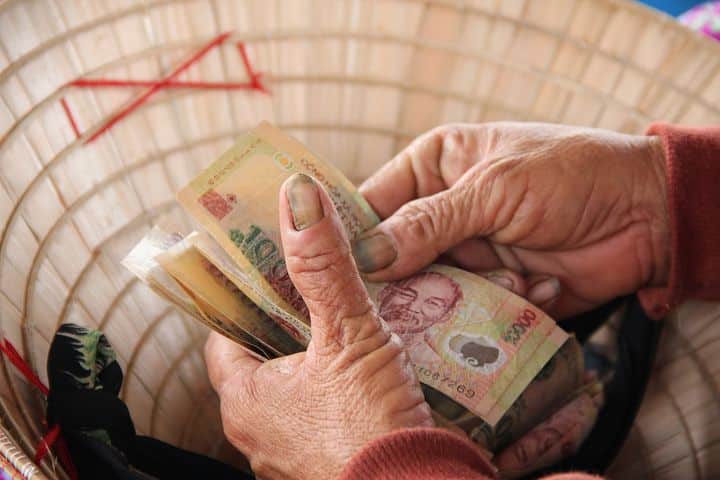
Maybe you’ve moved away from Vietnam to live and work in a new country, and now you’re looking to send money back to your loved ones at home. Or you may intend to travel to Vietnam for business or on vacation and will need to exchange money once you arrive. Either way, the last thing you’ll want to do is to pay high transfer fees or get uncompetitive exchange rates.
Whether you want to convert the euros, the pounds, the dollar, or any other currency into Vietnamese currency, it’s useful to have an understanding of exactly how it all works. This way, you’ll be able to make an informed decision when sending money to Vietnam to support the people closest to you. This guide created by our team here at Remitly covers all the basics on one handy page.
About the official currency of Vietnam
Since 1978, the official currency of Vietnam has been the dong, issued and regulated by the State Bank of Vietnam. The currency symbol for Vietnam is ₫, while the currency code is VND. The currency code appears after the monetary amount, such as 1,000 VND or 5,000 VND.
On the front, all Vietnamese banknotes have a portrait of Ho Chi Minh, the revolutionary who served as President from 1945 to 1969. The images on the back vary by denomination, and the material used for the banknotes differs from bill to bill.
Here are the banknotes currently in circulation as Vietnam currency:
- 100 VND: Blackish-brown cotton paper bills with an image of Pho Minh Tower on the back
- 200 VND: Reddish-brown cotton paper notes with an image of a tractor representing the agricultural industry on the back
- 500 VND: Dark red cotton paper banknotes with an image of ships on the back
- 1,000 VND: Purple cotton paper notes with an image of a timbering operation on the back
- 2,000 VND: Dark brown cotton paper bills with an image of a weaving workshop on the back
- 5,000 VND: Dark blue cotton paper material with an image of Tri An Hydropower Plant on the back
- 10,000 VND: Dark brown and green polymer material with an image of oil rigs on the back
- 20,000 VND: Dark blue polymer material with an image of the Pagoda Bridge on the back
- 50,000 VND: Red and purplish-brown polymer material with an image of Nha Rong Port on the back
- 100,000 VND: Dark green polymer banknotes with an image of the Temple of Literature on the back
- 200,000 VND: Brownish-red polymer banknotes with an image of Ha Long Bay on the back
- 500,000 VND: Blue and purple polymer banknotes with an image of Ho Chin Minh’s home in Kim Lien on the back
The State Bank of Vietnam is also responsible for minting coins. Vietnamese dong coins include:
- 200 VND: Nickel-plated steel coins with a plain edge, showing the emblem of Vietnam on one side and the denomination on the other
- 500 VND: Nickel-plated steel coins with an alternate reeded edge, displaying the emblem of Vietnam on one side and the denomination on the other
- 1,000 VND: Bronze-plated steel coins with a continuous reeded edge, featuring the emblem of Vietnam on one side and an image of Đô Temple on the other
- 2,000 VND: Bronze-plated steel coins with an alternate reeded edge, showcasing the emblem of Vietnam on one side and an image of the Communal House on Stilts on the other
- 5,000 VND: Nickel, copper, and aluminum coins with a shell-like reeded edge, decorated with the emblem of Vietnam on one side and the One Pillar Pagoda on the other.
Learn more about the Vietnamese dongs by checking out these five facts you may not know.

Currency exchange explained
Before we get into how to exchange the dong for other major currencies, it’s good to have a basic understanding of how currency exchanges work.
An exchange rate tells you how two currencies compare with each other, value-wise. In other words, it lets you know how much of a particular currency you can purchase with the other. The exchange rates between dong and other foreign currencies fluctuate in response to economic conditions.
Let’s say you’ve moved from Vietnam to the United States and want to send money back to your relatives. Checking the exchange rate, you see that 1 USD = 22,656.00 VND (the hypothetical exchange rate).
This tells you that, at this precise moment in time, you can purchase 22,656 dong with one US dollar. Several months before, perhaps you would have been able to buy 23,410 dong with a single USD. In fact, shifting rates mean that the conversion amount may change from one minute to the next.
There are a number of elements that can influence exchange rates, including:
- Interest rates
- Inflation
- Government debt
- Import/export activity
- Political instability
- Economic instability
- Demand for the currency by international traders
If there’s a new political development in the country, it might have significant repercussions on how the currency is valued in the global markets. The key thing to take away from all of this is that sending money to Vietnam can result in your recipient getting different amounts in dong depending on the exact moment you choose to make the remittance.
Why can the Vietnamese dong conversion be so high?
The Vietnamese dong is one of the weaker currencies in the world right now. This explains why you’re able to convert single units of currencies, such as dollars and euros, into such a large amount of dong.
The reasons for this are multi-faceted and rooted in long-standing socioeconomic factors stemming back to 1986 when the country shifted from a purely centrally-run economy to more of a free market economy.
Years of inflation and a relative lack of interest in the dong by foreign traders have helped keep the value of the currency low. There has also been some controversy in recent times, with the US Treasury alleging in 2020 that the Vietnamese government had been intervening to deliberately keep the dong low to make exports from Vietnam cheaper.
Fortunately, you can avoid delving into the thorny complexities of international economics in order to land the best dong exchange rates. The easiest way to send money to Vietnam without paying over the odds is to find a remittance service that doesn’t charge high fees or apply a disadvantageous exchange rate.
Finding the best dong exchange rate
When exchanging currency for Vietnamese dong, it’s useful to know how the remittance service provider calculates the exchange. By looking at the numbers yourself, you can make a clear-eyed comparison between the different options. The formula for working out the currency conversion is simple and looks like this:
Send currency x Exchange Rate = Receive Amount
Let’s consider some hypothetical scenarios to put this formula into a real-life context. You can, of course, change these numbers to reflect whatever you’re looking to transfer or exchange.

How to find euro to Vietnamese dong rates
Imagine you want to send 100 EUR to Vietnam. The calculation using the current euro to Vietnamese dong exchange rate at the time of writing would be:
100 EUR x 25,291.69 VND = 2,529,169.23 VND
At this point, you can subtract any relevant fees to see what your recipient will actually receive in Vietnam. Let’s say your remittance company or bank applies a €10 fee for each transfer. This would equate to 252,916.92 dong. Subtracting this from the overall amount, you’ll see what the recipient will actually get:
2,529,169.23 VND – 252,916.92 VND = 2,276,252.31 VND
If the fee were lower for each transfer, the person receiving the Vietnamese dong would end up with more money.
How to find USD to Vietnamese dong rates
To take another example, say you’re transferring 100 USD to someone in Vietnam. Based on the USD to Vietnamese dong exchange rates at the time of writing, the calculation of this would be:
100 USD x 23,487.50 VND = 2,348,750.00 VND
Again, you’ll just have to subtract any applicable fees to see what the final amount in dong will be.
Tips for exchanging other currencies for the Vietnam dong
Exchanging banknotes from your home country for dong in person can ensure that you have the cash to pay for things during a great vacation or business trip. If it’s your first time exchanging foreign currencies for Vietnamese dong, follow these tips to have the best experience possible.
Opt for a mix of denominations
When exchanging your currency for Vietnam currency, larger denominations like 10,000 VND and above will be the most useful. However, it’s still a good idea to get a few lower denominations when you exchange banknotes so that you can easily pay for small purchases like cab fare, vending machines, and street food.
Choose exchange services carefully
Banks and hotels are typically the safest places to exchange banknotes in Vietnam. These places are most likely to have transparent exchange fee policies and to provide fair exchange rates.
While you can exchange currency at the airport in Hanoi, Ho Chi Minh City, or Da Nang, the exchange rates may not be as good, and the fees are likely higher.
Some jewelers and gold shops will also exchange currency, and in some cases, they don’t charge exchange fees. However, they may set a limit on the maximum amount you can exchange.
Consider ATMs
International tourists can generally withdraw dong from ATMs in Vietnam. ATMs are located in most cities and even some smaller towns in Vietnam.
If you choose to withdraw cash using your ATM card, be aware that banks usually charge fees for accessing the ATM and converting other currencies to dong. It’s a good idea to contact your bank before your journey to Vietnam to find out the price of any fees.
To ensure safety, look for an ATM in a crowded, well-lit public place. Be discreet as you put the banknotes in your wallet or bag.
Inquire about using USD
Many hotels, restaurants, and large stores in major Vietnamese cities do accept USD as well as dong. If you’re from the U.S. and know ahead of time where you’ll be shopping and dining, you may want to call ahead to see if you can use the American dollar to pay.
Sending money to Vietnam: converting to dong
If you’re looking to convert the U.S. dollar, the euro, the pound, the riyal, or another currency into Vietnamese dong electronically to transfer, there are two main options to choose from: banks and transfer services.
Banks
It’s natural to consider your bank a convenient option when sending cash to Vietnam. As your funds are already sitting in your account, it’s simply a matter of instructing the bank to make the transfer, with no need to create a third-party account elsewhere.
Money transfer services
You may find that using a dedicated transfer service is a more affordable way to make a EUR to VND, USD to VND, GBP to VND, or any other currency to VND exchange. Transfer companies based entirely online, such as Remitly, don’t have to pay the high running costs of brick-and-mortar premises, which often means they can afford to charge lower fees to their customers.

Using Remitly to send money to Vietnam
The digital transfer company Remitly has partnerships with a range of trusted financial institutions in Vietnam. This means you can easily transfer dong to your family and friends back home whenever you need to.
To get started with Remitly, you just need to set up an account — which you can do through the website or mobile app. All that’s required is some basic personal details like your name, phone number, and payment information. You’ll then be able to select how you’d like to send money to Vietnam, entering your recipient’s details when prompted. We may ask for additional documentation depending on the amount sent or if we are unable to verify your identity.
Thanks to Remitly, your loved one can receive dong in multiple ways. You can transfer the money directly to their bank or mobile payment account. Alternatively, they can go to a designated location to pick up the remittance in cash or even have the money delivered to their door by courier.
To know what the exchange rates are right now, click here for US dollars to dong, here for pounds to dong, here for euros to dong, here for Australian dollars to dong, and here for Canadian dollars to dong.
Converting Vietnamese dong to USD and other major currencies
While sending money to Vietnam is straightforward, doing the reverse can be a more time-consuming process. The extra challenges are because Vietnamese people may have to produce documents to verify they are requesting dong to dollar, dong to pound, dong to euro, or similar transfers for an allowable reason. For example, they may need proof that they’re paying for university fees or overseas medical bills, supporting relatives abroad, or funding work trips and holidays.
What about exchanging VND in-person outside of Vietnam?
It’s possible to exchange Vietnamese dong for other currencies while you’re abroad. The options you may be able to use include:
- Brick-and-mortar currency exchange desks
- Local bank branches
- ATMs
- Bank card transactions
- Bank wires
Currency exchange desks and banks can be convenient, as these are found scattered throughout so many cities and towns across the world, and you’ll often be able to exchange currencies spontaneously without planning ahead. However, you may not get the most beneficial rates or lowest fees in this way.
Similarly, while using your Vietnamese bank card to make payments and withdraw local currency from ATMs may be a lower-effort way to make transactions, it can also be an expensive option. High fees may be charged when you do this.
If you’re settling in a country for a long time, creating a local bank account may be a cheaper, more practical option. Read our guides to opening a bank account in the US, the UK, France, and Australia.
Getting the best deal
As this guide has shown, you have your pick of ways to exchange currency for Vietnamese dong and send money to Vietnam.
To choose the right option, it’s important to consider exchange rates, exchange fees, and convenience and to take time to do some research. After all, having worked hard in your new country, you probably don’t want to spend too much when sending money home or having the exciting experiences of your vacation overshadowed by a bad experience using exchange services.
Start looking into the options available now, so you can choose an in-person currency exchange service or remittance method that will allow you to obtain Vietnamese dong or send money for the best possible rate.
Visit the homepage, download our app, or check out our Help Center to get started.
